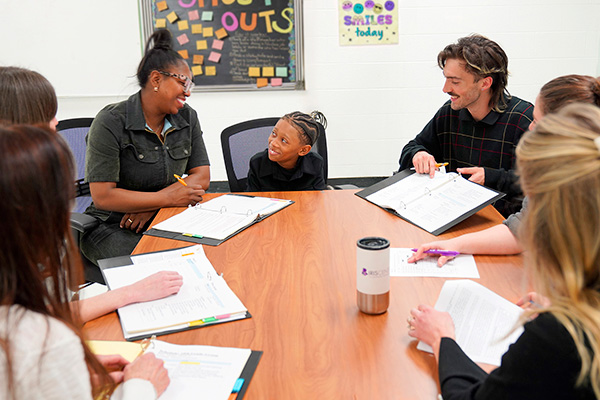How can educators determine why students are engaging in these behaviors?
Page 3: Reducing Subjectivity
 It is often easy for educators to recognize when an interfering behavior is happening and how it is impacting the classroom, but determining why it occurs can be very subjective. Without the systematic approach of an FBA, educators might make incorrect assumptions about a student’s behavior based on opinions, feelings, inaccurate recollections, or incomplete information. Two effective strategies for minimizing subjectivity throughout the FBA process are taking a team approach and addressing bias.
It is often easy for educators to recognize when an interfering behavior is happening and how it is impacting the classroom, but determining why it occurs can be very subjective. Without the systematic approach of an FBA, educators might make incorrect assumptions about a student’s behavior based on opinions, feelings, inaccurate recollections, or incomplete information. Two effective strategies for minimizing subjectivity throughout the FBA process are taking a team approach and addressing bias.
Taking a Team Approach
Did You Know?
Many states and school districts have adopted specific FBA guidelines, procedures, or templates to be used in their schools. Educators should communicate with school or district administrators to ensure that they are following all relevant requirements.
Purposely including multiple perspectives throughout the FBA process helps to minimize the subjectivity involved in interpreting the function of a behavior. One recommended way to do this is to take a team-based approach. Ideally, the team should be led by someone knowledgeable about the FBA process, such as a behavior specialist, school psychologist, or special educator. The FBA team should also include the student and their parents as well as a variety of school staff who are involved with the student, such as general education teachers, special education teachers, and other relevant professionals (e.g., school counselors, school psychologists, administrators).
parents
In the context of education, the term parent can include not only biological or adoptive parents but also anyone authorized to serve in their place (e.g., stepparents, grandparents, guardians, foster parents, court-appointed surrogate parents) when making educational decisions for a student.
Addressing Preconceptions
Educators naturally form perceptions about their students and their behavior. These perceptions are shaped by educators’ background knowledge and life experiences. Some perceptions can reflect unconscious preconceptions or stereotypes that influence a person’s understanding of and actions toward individuals, groups, or situations. These perceptions can relate to aspects of a person’s identity, such as gender, race, disability, cultural or linguistic background, religion, and socioeconomic status. For example, if an educator unconsciously holds stereotypes that students from certain backgrounds are prone to aggression, they might be more likely to label a behavior as aggressive when it is exhibited by a student from this group. Or an educator could interpret a student’s communication style as disrespectful or defiant rather than recognizing it as a cultural difference.
For Your Information
Behaviors that are considered appropriate or expected can vary by culture. For example, in some cultures, challenging conventional thought is seen as a sign of engagement and critical thinking rather than disrespect. Additionally, some behaviors characteristic of autism (e.g., rocking, hand flapping, lack of eye contact) have historically been treated as undesired, even when they do not interfere with learning. When determining which behaviors to target for change, educators should focus on those that negatively impact learning rather than those that simply deviate from a traditional norm of school behavior.
Although everyone has unconscious preconceptions or implicit biases, there are ways to reduce their unintended harmful impacts on students. For example, members of the FBA team should:
implicit bias
in glossary
- Think about their own backgrounds, perspectives, values, and attitudes
- Seek to understand the various aspects of their students’ backgrounds, values, and attitudes
- Consider how any significant disparity in worldviews, values, and expectations that exist between a teacher (or the school culture as a whole) and racially, ethnically, and socioeconomically diverse students could influence a student’s behavior or the educator’s interpretation of that behavior
- Embrace an asset-based approach to assessment
asset-based approach
in glossary
These strategies can help educators conduct FBAs that are as objective as possible. In these interviews, Bettie Ray Butler discusses how negative perceptions and misconceptions can show up in an FBA. Next, she offers advice on how being critically introspective can help reduce the impact of these negative perceptions and misconceptions when conducting an FBA.

Bettie Ray Butler, PhD
Professor of Urban Education
University of North Carolina at Charlotte
Reducing Subjectivity in the FBA Process
Considerations for the FBA Team
(time: 3:20)
Transcript: Bettie Ray Butler, PhD
Reducing Subjectivity in the FBA Process
First, it’s important to understand what implicit bias is. It’s simply unconscious beliefs that surface and tend to dictate how you respond and react in certain situations. It is important to mention we all have implicit biases, and they all tend to shift and shape how we communicate and respond with one another.
So with that, implicit bias has to be an important consideration in the FBA process because one of the key features of the FBA is understanding what is and is not desirable behavior. And if you are asking an individual to make that determination, surely cultural norms come into play. Cultural norms being, How were you raised? What was your childhood like? What have you been taught? And so when we think about implicit bias, these are some of the ingrained thoughts that we have when we talk about what is and is not acceptable behaviors. But it’s important to ask, Why do we believe this? Because we could hold beliefs about desirable behavior that are in direct opposition to someone’s culture.
We also know that sometimes implicit bias, because we have and hold these assumptions about certain groups, can cause us to be hyperfocused on certain children or certain youth behavior. Whereas other very similar types of behavior from maybe a youth that is not from a racially or ethnically diverse background is similar, but it’s oftentimes either ignored or is not the focal point. So implicit bias can cause us to see a child walk in a room and have the assumption that they’re going to be hostile, they’re going to be aggressive. And we can be hyperfocused on all of their actions and responses, just waiting for that confirmation bias to show up. And I think that’s how implicit bias can show up in the FBA process.
Implicit bias can also cause us to make assumptions about why the behavior is present. If there is a child that appears to be disengaged, their disengagement may not be associated with a hard life, but their disengagement could be because of their lack of seeing themselves in the curriculum. Their disengagement could be a function of something that the educator is projecting that causes the student to not necessarily feel that sense of trust, feel that sense of belonging in a classroom space. And so it’s important for us to always look introspectively to understand why we feel and believe what we do and how our beliefs may have a negative impact in a classroom space.
Transcript: Bettie Ray Butler, PhD
Considerations for the FBA Team
I would always recommend that FBA teams first focus on inclusion. Consider who is making up the FBA team. Oftentimes, we are satisfied when the FBA teams consist of just school officials. It is necessary but not sufficient. The FBA team should be a balance of school officials and those who support school culture, and the families, the parent, and the student, and all those who represent the student’s home culture. That could mean an advocate in the form of a community leader or a grandparent, someone who they trust and who knows the student well.
Being able to identify potential biases is also another way to be critically reflective. What preconceived notions have I brought into the defining of the behavior? What preconceived notions have I brought into the interpretation and the analysis of the behavior? And so to just constantly ask these questions of oneself and then to take the appropriate action to disassemble or dismantle these biases or assumptions is really important.
And just like we should not make assumptions about the student, we should not also make assumptions about their family and their family’s capacity to provide knowledge and understanding of behaviors. If we are going to use a critical lens in our reflective process, we must always see the parent as the expert. They are our coresearchers. They are our team members. They are not inconsequential to the process. Even if they don’t use the same verbiage and language that we’re accustomed to using, their insight, their perspective is deeply important as we go through or collect and analyze FBA data.
Also, I can’t overemphasize the demonstration of care and empathy. I always tell educators, “Think as if this was your child or your niece or someone that was very close to you in a familial sense. How would you desire the FBA process to commence? What things would be paramount for you if this was someone that was intimately tethered to your life?” And so that is a mindset that we must operate in continuously when we are approaching students from varied backgrounds. And that also goes back to be culturally responsive. It is not a checklist of strategies. It is a complete shift in how we think. And it is a constant reflection of if we think this way, why do we think this way? Knowing why we believe what we believe or value. And if we are doing these things and we are shifting our mindsets in those ways, then the demonstration of care and empathy comes easy.
Throughout the FBA process, teams should strive to collect impartial, comprehensive, and accurate data on the student’s interfering behavior. In the remainder of this module, you will learn more about each of the steps in the FBA process:
- Developing an operational definition of the behavior to be assessed
- Collecting indirect assessment data
- Conducting descriptive assessments
- Interpreting the data to craft a hypothesis statement